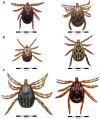Tick-borne zoonoses and commonly used diagnostic methods in human and veterinary medicine
- PMID: 33459849
- PMCID: PMC8599405
- DOI: 10.1007/s00436-020-07033-3
Tick-borne zoonoses and commonly used diagnostic methods in human and veterinary medicine
Abstract
Around the world, human health and animal health are closely linked in terms of the One Health concept by ticks acting as vectors for zoonotic pathogens. Animals do not only maintain tick cycles but can either be clinically affected by the same tick-borne pathogens as humans and/or play a role as reservoirs or sentinel pathogen hosts. However, the relevance of different tick-borne diseases (TBDs) may vary in human vs. veterinary medicine, which is consequently reflected by the availability of human vs. veterinary diagnostic tests. Yet, as TBDs gain importance in both fields and rare zoonotic pathogens, such as Babesia spp., are increasingly identified as causes of human disease, a One Health approach regarding development of new diagnostic tools may lead to synergistic benefits. This review gives an overview on zoonotic protozoan, bacterial and viral tick-borne pathogens worldwide, discusses commonly used diagnostic techniques for TBDs, and compares commercial availability of diagnostic tests for humans vs. domestic animals, using Germany as an example, with the aim of highlighting existing gaps and opportunities for collaboration in a One Health framework.
Keywords: Diagnostics; ELISPOT; Lyme borreliosis; Metazoonoses; One Health; PCR; Serology; Tick-borne diseases; Ticks; Zoonoses.
© 2021. The Author(s).
Conflict of interest statement
The authors declare that they have no conflict of interest.
Figures



References
-
- Baek YH, Cheon HS, Park SJ, Lloren KKS, Ahn SJ, Jeong JH, Choi WS, Yu MA, Kwon HI, Kwon JJ, Kim EH, Kim YI, Antigua KJC, Kim SY, Jeong HW, Choi YK, Song MS. Simple, rapid and sensitive portable molecular diagnosis of SFTS virus using reverse transcriptional loop-mediated isothermal amplification (RT-LAMP) J Microbiol Biotechnol. 2018;28:1928–1936. doi: 10.4014/jmb.1806.06016. - DOI - PubMed
Publication types
MeSH terms
Grants and funding
LinkOut - more resources
Full Text Sources
Other Literature Sources
Medical
Miscellaneous

